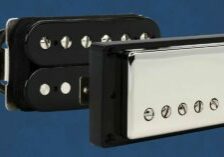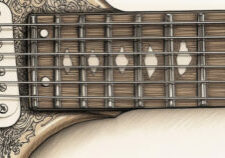Introduction
This guide provides an overview of the different types of pickup magnets commonly used in electric guitars and their tonal characteristics. Understanding the differences between these magnets can help guitar players make informed decisions when selecting pickups for their instruments.
Alnico Magnets
When it comes to electric guitar pickups, the type of magnet used can have a significant impact on the tone produced. One of the most popular types of magnets used in pickups is Alnico. In this article, we will explore the different types of Alnico magnets and their tonal characteristics.
Alnico magnets are made from a combination of aluminum, nickel, and cobalt. They were first developed in the 1930s and have been used in guitar pickups ever since. There are several different types of Alnico magnets, each with its own unique tonal characteristics.
Alnico II magnets are known for their warm and sweet tone. They have a lower output than other Alnico magnets, which makes them ideal for clean and bluesy playing styles. Alnico II magnets are often used in neck pickups because they produce a smooth and mellow sound that complements the warmer tones produced by the neck position.
Alnico III magnets are similar to Alnico II magnets but with slightly higher output. They produce a bright and clear tone that is well-suited for rhythm playing. Alnico III magnets are often used in middle pickups because they provide a balanced sound that complements both the neck and bridge positions.
Alnico IV magnets have a higher output than Alnico II and III magnets. They produce a punchy and dynamic tone that is well-suited for rock and metal playing styles. Alnico IV magnets are often used in bridge pickups because they provide a powerful sound that cuts through the mix.
Alnico V magnets are the most common type of Alnico magnet used in guitar pickups. They have a high output and produce a bright and punchy tone that is well-suited for lead playing styles. Alnico V magnets are often used in both neck and bridge pickups because they provide a balanced sound that complements both positions.
Alnico VIII magnets are the highest output Alnico magnets available. They produce a powerful and aggressive tone that is well-suited for heavy metal playing styles. Alnico VIII magnets are often used in bridge pickups because they provide a high level of sustain and distortion.
In addition to the different types of Alnico magnets, there are also variations in the way they are magnetized. Some pickups use a traditional magnetization pattern, while others use a reverse magnetization pattern. Reverse magnetization can produce a slightly different tone, with more emphasis on the treble frequencies.
It’s important to note that while the type of magnet used in a pickup can have a significant impact on the tone produced, it is not the only factor. Other factors such as the number of windings on the pickup coil, the gauge of wire used, and the type of pickup construction can also affect the tone produced.
In conclusion, Alnico magnets are a popular choice for guitar pickups due to their unique tonal characteristics. Each type of Alnico magnet produces a different sound, from warm and mellow to bright and punchy. When choosing a pickup for your guitar, it’s important to consider the type of magnet used and how it will complement your playing style.
Ceramic Magnets
When it comes to electric guitar pickups, the type of magnet used can have a significant impact on the tone produced. One of the most common types of magnets used in pickups is ceramic magnets. In this article, we will explore what ceramic magnets are, how they work, and their tonal characteristics.
Ceramic magnets are made from a composite of iron oxide and barium or strontium carbonate. They are known for their strength and durability, making them a popular choice for use in pickups. Ceramic magnets are also relatively inexpensive compared to other types of magnets, which makes them an attractive option for guitar manufacturers.
In terms of how they work, ceramic magnets create a magnetic field that interacts with the strings of the guitar. When the strings vibrate, they disturb the magnetic field, which generates an electrical signal that is sent to the amplifier. The strength of the magnetic field determines how much signal is generated, which in turn affects the overall output level and tone of the pickup.
One of the key tonal characteristics of ceramic magnets is their high output level. This means that they produce a strong signal that can drive an amplifier hard and create a lot of distortion. This makes them a popular choice for heavy rock and metal styles where a lot of gain is required.
However, this high output level can also result in a somewhat harsh or brittle tone. Ceramic magnets tend to emphasize upper midrange frequencies, which can make them sound bright and cutting. This can be useful for lead playing or soloing where you want your notes to stand out in the mix, but it may not be ideal for rhythm playing or more subtle styles.
Another factor to consider with ceramic magnets is their sensitivity to string spacing. Because they have a strong magnetic field, they can sometimes pull on the strings unevenly if they are too close together. This can result in an unbalanced tone with some strings sounding louder than others. To avoid this issue, some pickup manufacturers use staggered pole pieces or adjust the magnet strength to compensate for different string spacings.
In terms of specific pickup models that use ceramic magnets, there are many options available. Some popular examples include the Seymour Duncan Invader, DiMarzio Super Distortion, and EMG 81. These pickups are often used in high-gain applications where a lot of distortion is desired.
Overall, ceramic magnets are a versatile and affordable option for guitar pickups. They offer a high output level and strong magnetic field that can drive an amplifier hard and create a lot of distortion. However, their emphasis on upper midrange frequencies can result in a somewhat harsh or brittle tone, which may not be ideal for all styles of music. If you’re looking for a pickup with a lot of power and aggression, ceramic magnets may be just what you need.
Neodymium Magnets
When it comes to guitar pickups, the type of magnet used can have a significant impact on the tone produced. One type of magnet that has gained popularity in recent years is the neodymium magnet.
Neodymium magnets are made from a combination of neodymium, iron, and boron. They are known for their strength and durability, making them a popular choice for many guitarists. In terms of tonal characteristics, neodymium magnets are often described as having a clear and articulate sound.
One of the main benefits of neodymium magnets is their high output. This means that they can produce a strong signal even with low string vibrations. As a result, guitars with neodymium pickups tend to have a more pronounced midrange and high-end frequencies.
Another advantage of neodymium magnets is their ability to maintain clarity even at high volumes. This makes them ideal for players who like to push their amps to the limit without sacrificing tone quality.
However, some guitarists find that neodymium pickups can be too bright or harsh for their taste. This is because the high output can sometimes result in an overly aggressive sound. To counteract this, some manufacturers use different winding techniques or combine neodymium magnets with other materials to achieve a more balanced tone.
It’s also worth noting that neodymium magnets are not as common as other types of magnets used in pickups. This is partly due to their higher cost compared to traditional ceramic or alnico magnets. However, for those who prioritize tone quality and durability, the investment may be worth it.
In terms of specific pickup models that use neodymium magnets, there are several options available on the market. One popular choice is the Seymour Duncan Pegasus/Sentient set, which features neodymium magnets in both the bridge and neck positions. These pickups are known for their clarity and versatility, making them suitable for a wide range of playing styles.
Another option is the Fishman Fluence Modern Humbucker set, which also uses neodymium magnets. These pickups are designed to provide a modern, high-gain sound without sacrificing clarity or definition.
Overall, neodymium magnets offer a unique tonal characteristic that can be beneficial for certain playing styles and genres. While they may not be as widely used as other types of magnets, their strength and durability make them a worthwhile investment for guitarists looking to achieve a clear and articulate sound.
Samarium Cobalt Magnets
When it comes to electric guitar pickups, the type of magnet used can have a significant impact on the tone produced. One type of magnet that has gained popularity in recent years is the Samarium Cobalt (SmCo) magnet.
Samarium Cobalt magnets are made from a combination of samarium and cobalt, along with small amounts of other elements such as iron, copper, and zirconium. They are known for their strength and durability, making them a popular choice for high-end pickups.
One of the main advantages of SmCo magnets is their ability to produce a clear and articulate tone. They have a strong magnetic field that allows them to pick up even the slightest vibrations from the strings, resulting in a more detailed and nuanced sound.
Another characteristic of SmCo magnets is their high output. This means that they can produce a louder signal than other types of magnets, which can be useful for players who want to push their amp into overdrive or distortion.
However, this high output can also be a drawback for some players. It can make the tone sound too harsh or aggressive, especially when playing with high gain settings. Additionally, SmCo magnets tend to have a narrower frequency response compared to other types of magnets, which can limit their versatility in certain styles of music.
Despite these limitations, many guitarists still prefer SmCo pickups for their unique tonal characteristics. They are particularly well-suited for genres like metal and hard rock, where clarity and definition are essential.
When choosing a pickup with SmCo magnets, it’s important to consider the other components of the pickup as well. The type of wire used in the coil winding process, as well as the shape and size of the pickup itself, can all affect the final tone produced.
In general, SmCo pickups tend to have a brighter and more focused sound compared to other types of pickups. They excel at producing tight and punchy rhythms, as well as cutting lead tones that can slice through a mix.
Some popular examples of pickups that use SmCo magnets include the Seymour Duncan Black Winter, the DiMarzio D Activator, and the Bare Knuckle Aftermath. These pickups are all designed with high-gain players in mind, and offer a powerful and aggressive tone that is perfect for heavy music.
In conclusion, Samarium Cobalt magnets are a unique and powerful option for guitar pickups. They offer a clear and articulate tone, as well as a high output that can be useful for players who want to push their amp into overdrive. While they may not be as versatile as other types of magnets, they are an excellent choice for genres like metal and hard rock where clarity and definition are essential. When choosing a pickup with SmCo magnets, it’s important to consider the other components of the pickup as well, in order to achieve the desired tone.
Humbucker Pickups
Humbucker pickups are a popular choice for guitarists who want a warm, full-bodied sound with plenty of sustain. These pickups use two coils instead of one, which helps to cancel out unwanted noise and hum. There are several different types of humbucker pickups available, each with its own tonal characteristics.
The most common type of humbucker pickup is the Gibson-style humbucker. These pickups have a warm, rich tone with plenty of midrange and bass frequencies. They are often used in rock and blues music, as they can provide a thick, powerful sound that cuts through the mix.
Another popular type of humbucker pickup is the Seymour Duncan-style humbucker. These pickups have a brighter, more articulate tone than Gibson-style pickups, with more emphasis on the high-end frequencies. They are often used in metal and hard rock music, as they can provide a sharp, cutting sound that works well with heavy distortion.
There are also vintage-style humbucker pickups available, which aim to replicate the sound of classic pickups from the 1950s and 60s. These pickups have a slightly lower output than modern humbuckers, which gives them a more dynamic and responsive feel. They also tend to have a slightly brighter tone than modern humbuckers, with more emphasis on the upper midrange frequencies.
One thing to keep in mind when choosing a humbucker pickup is the output level. Higher-output pickups will provide more sustain and distortion, but may also be prone to feedback and noise. Lower-output pickups will have a more dynamic feel and cleaner tone, but may not be as suitable for heavy distortion.
It’s also worth considering the construction of the pickup itself. Some humbuckers use Alnico magnets, which provide a warm, vintage-style tone with plenty of midrange frequencies. Others use ceramic magnets, which provide a brighter, more aggressive tone with more emphasis on the high-end frequencies.
Ultimately, the best way to choose a humbucker pickup is to try out several different options and see which one sounds best to your ears. It’s also worth considering the other components in your guitar, such as the wood type and bridge design, as these can have a significant impact on your overall tone.
In conclusion, humbucker pickups are a versatile and popular choice for guitarists who want a warm, full-bodied sound with plenty of sustain. There are several different types of humbucker pickups available, each with its own tonal characteristics. When choosing a humbucker pickup, it’s important to consider factors such as output level, magnet type, and construction. Ultimately, the best way to find the right pickup for your needs is to try out several different options and see which one sounds best to your ears.
Single Coil Pickups
Single Coil Pickups
Single coil pickups are the oldest type of pickup and are still widely used today. They consist of a single coil of wire wrapped around a magnet, which generates an electrical signal when the strings vibrate above it. Single coil pickups have a bright, clear tone with plenty of high-end sparkle and a tight, focused low-end.
One of the most famous examples of single coil pickups is the Fender Stratocaster. The Stratocaster’s three single coil pickups are known for their bright, twangy tone that’s perfect for country and blues music. Other popular guitars that use single coil pickups include the Telecaster, Jaguar, and Jazzmaster.
Single coil pickups are also known for their noise. Because they only have one coil, they’re more susceptible to picking up electromagnetic interference from other electronic devices. This can result in a humming or buzzing sound when you’re not playing anything. To combat this, many guitarists use noise-cancelling pickups or add shielding to their guitar’s electronics.
There are several different types of single coil pickups available, each with its own tonal characteristics. Here are some of the most common:
Vintage-style single coils: These pickups are designed to replicate the sound of vintage Fender pickups from the 1950s and 60s. They have a bright, clear tone with plenty of midrange punch and a slightly scooped midrange.
Hot single coils: Hot single coils have a higher output than vintage-style pickups, which gives them more distortion and sustain. They’re great for rock and metal music where you need a lot of gain.
Noiseless single coils: As mentioned earlier, single coil pickups can be noisy. Noiseless single coils use special wiring and magnets to cancel out unwanted noise while still retaining the classic single coil tone.
Stacked single coils: Stacked single coils are similar to noiseless pickups in that they use special wiring to cancel out noise. However, they’re designed to look and sound like traditional single coils. They have a slightly warmer tone than regular single coils and are great for blues and jazz music.
Single coil-sized humbuckers: If you love the look of a Stratocaster but want a thicker, more powerful tone, single coil-sized humbuckers are a great option. These pickups fit into a standard single coil slot but have two coils instead of one, which gives them a fatter, more aggressive sound.
In conclusion, single coil pickups are an essential part of many guitarists’ setups. They offer a bright, clear tone that’s perfect for country, blues, and rock music. While they can be noisy, there are several different types of single coil pickups available that offer noise-cancelling technology without sacrificing tone. Whether you’re looking for vintage-style pickups or something with more output and distortion, there’s a single coil pickup out there that will suit your needs.
P90 Pickups
P90 pickups are a type of single-coil pickup that was first introduced by Gibson in the late 1940s. They are known for their warm, fat tone and have been used by many famous guitarists over the years, including Carlos Santana, Pete Townshend, and Johnny Thunders.
One of the main differences between P90 pickups and other types of single-coil pickups is their size. P90s are larger than traditional Stratocaster-style pickups, which gives them a wider frequency response and more output. This makes them ideal for players who want a thicker, more powerful sound.
Another characteristic of P90 pickups is their midrange emphasis. Unlike some other types of pickups that have a scooped midrange, P90s have a pronounced midrange that gives them a unique tonal character. This makes them great for playing blues, rock, and other styles of music where a strong midrange is desirable.
There are two main types of P90 pickups: soapbar and dog ear. Soapbar P90s are named for their rectangular shape, which resembles a bar of soap. They are typically found on Gibson guitars and other brands that use Gibson-style pickups. Dog ear P90s, on the other hand, have rounded edges that resemble the shape of a dog’s ear. They were originally used on early Les Paul Junior models and have since become popular with many players.
In terms of tonal characteristics, there is not much difference between soapbar and dog ear P90s. Both types have a warm, fat tone with plenty of midrange emphasis. However, some players prefer the look of one type over the other, so it ultimately comes down to personal preference.
One thing to keep in mind when using P90 pickups is that they can be prone to noise and hum. This is because they are single-coil pickups, which means they are susceptible to electromagnetic interference from other sources. To combat this, many P90-equipped guitars come with a humbucker in the bridge position, which cancels out the noise.
Overall, P90 pickups are a great choice for players who want a warm, fat tone with plenty of midrange emphasis. They are versatile enough to be used in a variety of musical styles and can add a unique character to any guitar. Whether you prefer soapbar or dog ear P90s, there is no denying the impact that these pickups have had on the world of guitar music.
Rail Pickups
Rail pickups are a type of pickup that is commonly used in electric guitars. They are known for their unique design, which consists of two parallel metal rails that run the length of the pickup. The rails are connected by a series of magnets, which create a magnetic field that picks up the vibrations of the guitar strings.
One of the main advantages of rail pickups is their ability to produce a clear and articulate sound. This is because the rails are able to pick up a wider range of frequencies than traditional single-coil pickups. As a result, rail pickups are often used in genres such as jazz and blues, where clarity and definition are important.
Another advantage of rail pickups is their low noise level. Because the rails are connected by magnets, they are able to cancel out any unwanted noise or interference that may be present in the signal. This makes them ideal for use in high-gain situations, such as heavy metal or hard rock.
There are several different types of rail pickups available on the market today. One popular option is the Seymour Duncan Hot Rails pickup. This pickup is known for its high output and aggressive tone, making it a favorite among heavy metal guitarists.
Another popular option is the DiMarzio Fast Track pickup. This pickup is designed to provide a smooth and balanced tone, making it ideal for use in genres such as blues and jazz.
Finally, there is the EMG HZ H4 pickup. This pickup is known for its high output and tight bass response, making it ideal for use in heavy metal and hard rock.
When choosing a rail pickup, it is important to consider your individual playing style and musical preferences. If you prefer a more aggressive tone, then a pickup like the Seymour Duncan Hot Rails may be the best choice for you. On the other hand, if you prefer a smoother and more balanced tone, then a pickup like the DiMarzio Fast Track may be more suitable.
It is also important to consider the type of guitar you will be using the pickup with. Some rail pickups are designed specifically for use with certain types of guitars, such as Stratocasters or Les Pauls. Make sure to choose a pickup that is compatible with your guitar to ensure the best possible sound.
In conclusion, rail pickups are a versatile and popular option for electric guitar players. They offer a clear and articulate sound, as well as low noise levels, making them ideal for use in a variety of genres. When choosing a rail pickup, it is important to consider your individual playing style and musical preferences, as well as the type of guitar you will be using it with. With the right pickup, you can achieve the perfect tone for your playing style and take your music to the next level.
Conclusion
Conclusion: Understanding the different types of pickup magnets and their tonal characteristics is crucial for guitar players looking to achieve their desired sound. Alnico magnets offer warmth and clarity, ceramic magnets provide a powerful and aggressive tone, while neodymium magnets offer a balanced and clear sound. Each type of magnet has its own unique properties that can greatly affect the overall tone of a guitar. It is important to experiment with different pickups and magnets to find the perfect combination for your playing style and musical preferences.





